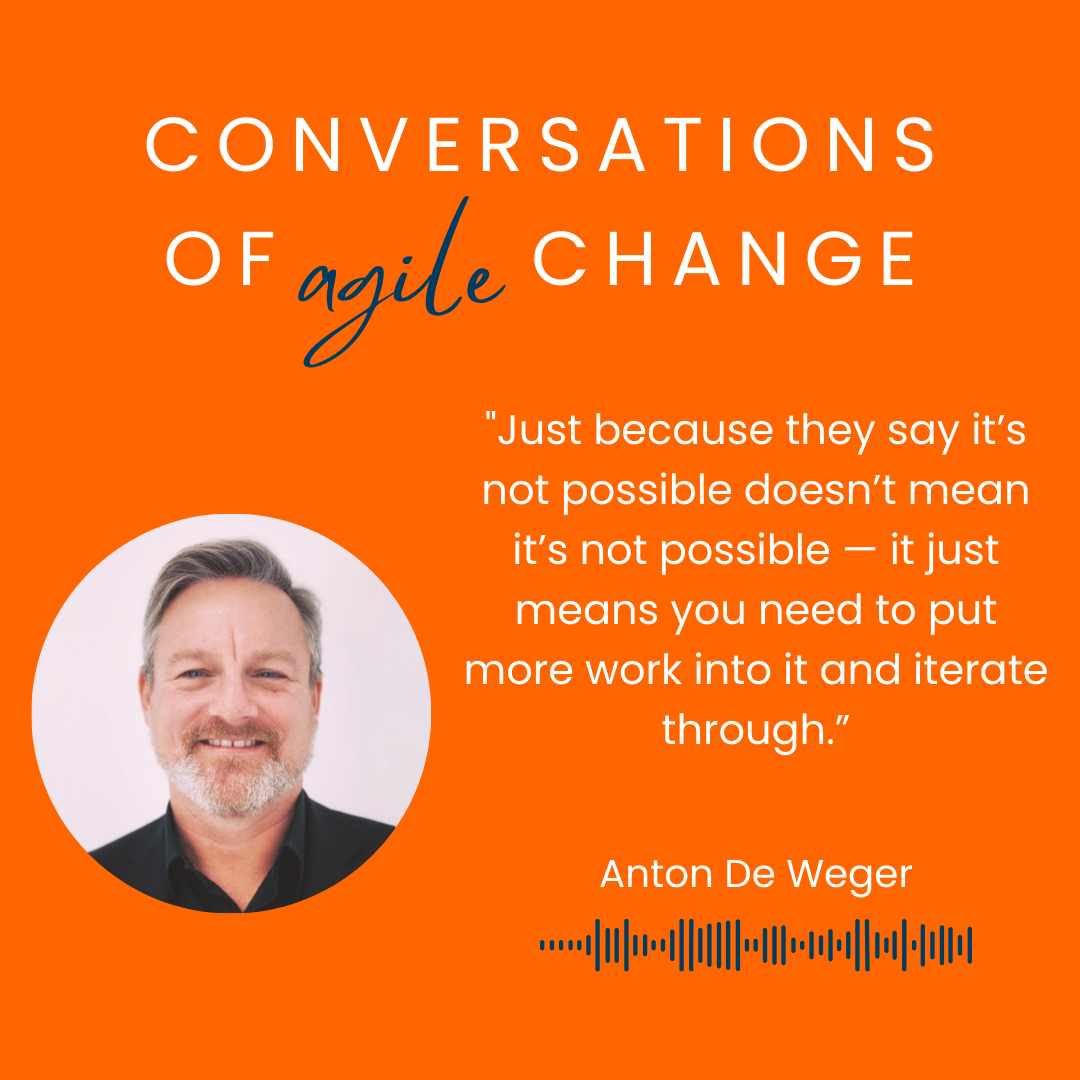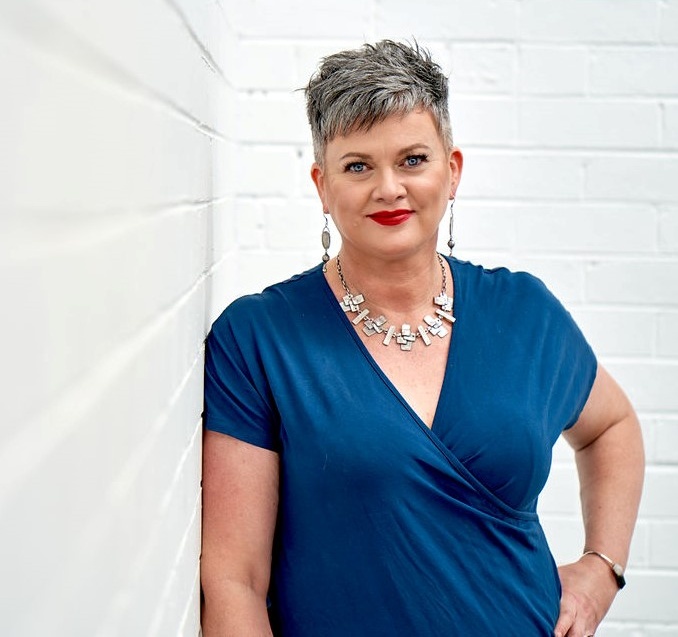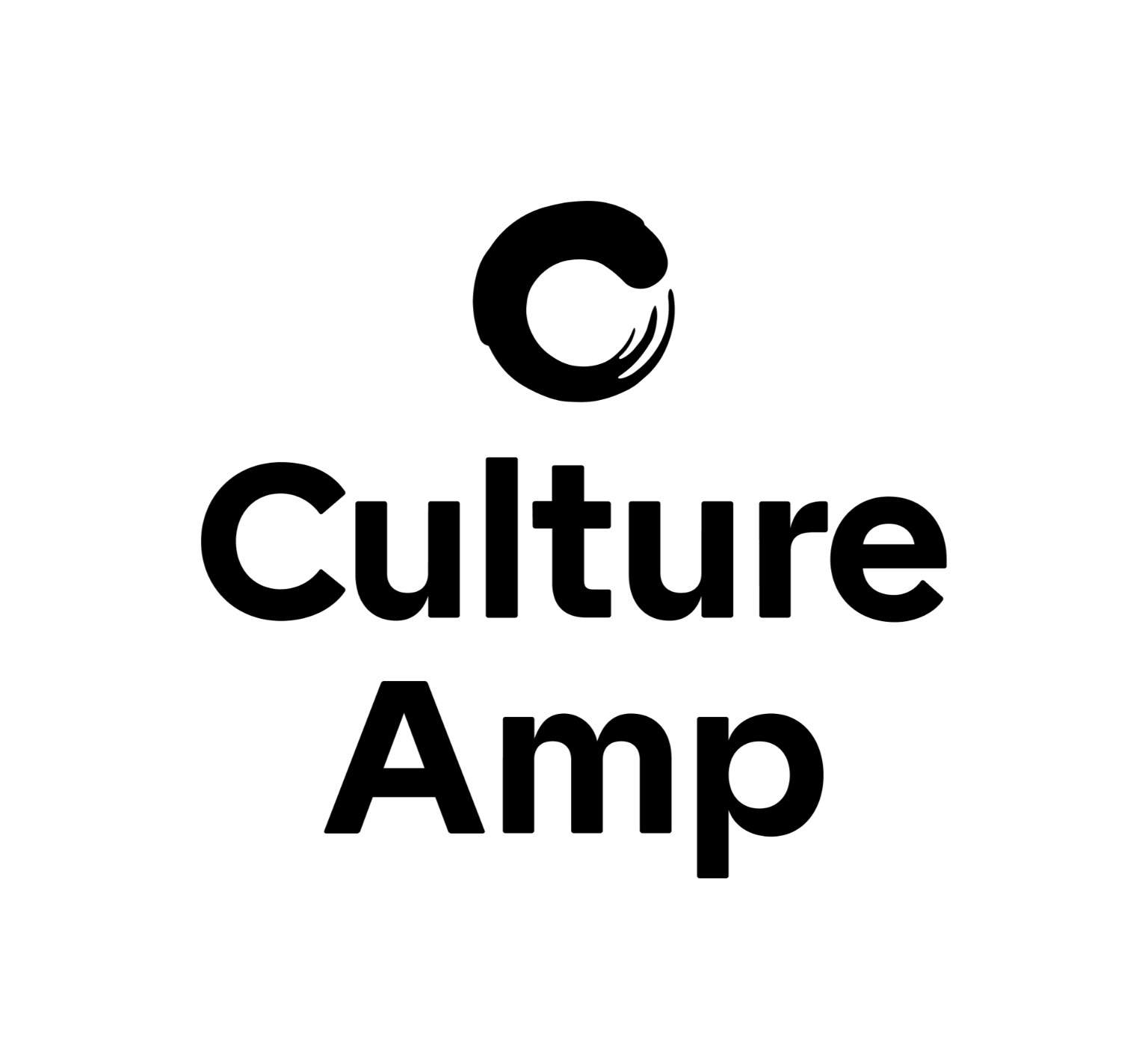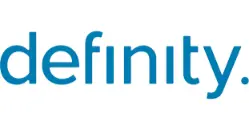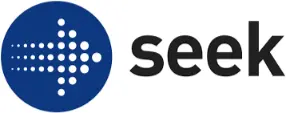Dr Jen Frahm:
And hello everybody. Welcome back to the 2025 series of Conversations of Agile Change. It’s lovely to have you back with us.
Now I have got a super special treat just to start us off this season. Many of you know that the standard for our podcast series is that we bring on alumni to talk about what they’re doing and bring to life their experiences of agile change. Today we’re going to deviate from that format because a couple of weeks ago, I heard an ex-colleague talking about a really fascinating experience. And in listening to the story that was being told, I could hear these vestiges of agile change and I thought, “This is so cool. This environment is not that dissimilar to what our people experience.” I want to bring to you Anton de Weger today on the podcast.
Anton, welcome to Conversations of Agile Change.
Anton de Weger:
Great to talk to you, Jen.
Dr Jen Frahm:
Excellent. So listeners and viewers, I actually worked with Anton, I said he was an ex-colleague, some I think about nine years ago on a global workday implementation. Anton was our data guru at the time.
Anton, tell us what have you been doing in those nine years?
Anton de Weger:
Well, I’ve continued on and still working in that kind of space for a little bit, which was the enterprise resource planning, so HR, payroll implementations. But I studied AI back at university a very long time ago, and I could see that the market was starting to change in around that 2015, 2016 type of timeframe into something where AI was becoming an implementation problem rather than research and development. So I switched over into starting to do AI implementations. And then I actually joined Workday on their machine learning strategy side and worked for them for a couple of years building up AI solutions with large data around HR and payroll finance, those kind of areas as well.
Dr Jen Frahm:
So you drank the Kool-Aid?
Anton de Weger:
Yes.
Dr Jen Frahm:
You enjoyed the product so much you joined the company?
Anton de Weger:
Yeah, well the opportunity was great. With 40 million people’s worth of employment history data in there, the opportunities were absolutely huge. And we spent a lot of time trying to, first of all, get access to that data in an appropriate way and making sure that it was well de-identified and able to use for machine learning.
But then it was all about developing a methodology because building machine learning solutions is actually quite different to normal software development. You need to know what the patterns are first before you can build your products, not the other way around. So I did that for a while, came back, did a bit of a startup in the podcast space, looking at transcriptions, understanding summaries, where to put ads into podcasts, chapters, that kind of stuff, cutting out snippets. And as it happens, we actually do a lot of audio processing for radio here in Australia. We do a number of sports podcasts and radio broadcasts where we scan through all of that content, looking for brand mentions, things like that.
And then I ended up here at The Florey, which is a neuroscience research facility, the largest one in the Southern Hemisphere, one of the top 10 in the world, dealing with epilepsy and all the data around that. And it has just been absolutely fantastic to see the cutting edge of brain science here and working with some really good people. But from a change perspective, it is been really interesting to work in this environment and use some of those techniques that I guess we originally saw over 10 years ago. And in some ways you introduced me to around that job.
Dr Jen Frahm:
That’s so interesting. I think what I really love about that story that you’ve shared is showing the variety that is the potential. So often, people get kind of a bit stuck in this sense of, “Who I am from a professional identity and what’s possible? What’s next?” And they get a bit stifled with that, but I think you’ve given the listeners a really good example of actually how you can move around within the same area of interest and do things really differently, which that’s agility in action.
I said I heard you speak at Tech Health on some of the wins you are having in this role that you’re in, the project that you’re working on with The Florey Institute. Can you start by telling us a little bit… Let’s unpack it one at a time. Let’s start with The Florey Institute. What is it that they do? Who do they serve? How might listeners understand the work that they do?
Anton de Weger:
So it is very much around neuroscience and mental health. So it’s a research organization reasonably closely linked with the University of Melbourne, here in the Parkville precinct is where their headquarters are. And they look at all aspects of how the brain works from right down at the genetics level through all of the chemicals and interactions all the way up to neuroscience or neuropsychology and even into brain surgery and how that can be used. So it’s a wide gamut, but all focused pretty much specifically on the brain.
Dr Jen Frahm:
Yeah, okay. That’s high-tech stuff too. So how does that translate as an environment to work in? So you are in a project or a program? What does that mean in terms of an environment?
Anton de Weger:
I worked in epilepsy project, and so we are focused solely on epilepsy and finding solutions in that space. And I work with some really amazing people. They’re world leaders in epilepsy and neuroscience. And they’re just so capable and they just know so much. It makes me feel really inadequate a lot of the time because they are just so knowledgeable about this area. That makes for a really interesting environment to work in. It makes it hard from a technology side. So I’ve come in from a technology side to build a platform and portals to help to automate their workflow and deliver a solution into healthcare here in Australia.
But as stakeholders, they are very technically savvy. They’ve built a lot of their own data models. They know how to do this in Python. And in some respects when I first came in, they didn’t really see the value of having somebody in from a technology perspective. And also they have to be seen as being experts. That’s where their granting comes from, is being the expert in the field, which means that they’re somewhat less likely to show a bit of vulnerability about what they don’t know and also want to know everything before they make a decision as well.
So there’s a number of challenges there from actually applying technology in this space and moving forward. And the way that it generally works is that they will come up with their requirements for what they want to build and then they’ll put those all down in a very large requirements document, go out to an external medical technology consultancy and come up with a very detailed fixed price contract, which then the consultancy goes off, builds the product, and a couple of years later comes back with a solution. And you can probably see where this is going. There’s been a lot of change in expectations, a lot of learning in that time, which then doesn’t really relate to the end results that they end up being seen, which ends up in cost overruns and change requests. Generally a bit more disappointment.
And we’ve seen that in lots of projects in this kind of area, whereas we kind of came in and took a little bit more of a hands-on approach where we decided that we were going to build the components that we needed and we were going to do it very quickly and outsource a lot of that build work over to a Vietnamese development company as well. So we did all of the stakeholder management, the requirements, the design locally, and then engage with this company to build and deliver in really quick sprints. So we started trying to deliver value very quickly. And that worked really well with our stakeholders. They went from being very critical of the processes and the designs to seeing it and then saying, “Oh, this is wrong. Isn’t working. This won’t work this way.” And then seeing a really quick turnaround of improvements and iterations. And then taking ownership of that a little bit more and seeing the end results going, “Oh yeah, we can use that. That looks right.” And that just worked really well with the stakeholders and [inaudible 00:09:28].
Dr Jen Frahm:
I think that’s really interesting to me on a couple of points. I want to tease out because I’m thinking of our listeners and typically in the environments they’re working in. Given it’s a private institute, I’m curious around the extent to which there’s this permissiveness about entrepreneurialness versus because it is medical, the level of regulation that occurs. Do those two fight up against each other or buttress up against each other? Are they in conflict or…
Anton de Weger:
Well, absolutely. Developing stuff in med tech is really, really difficult. It starts from the point that nobody really wants to pay for it, especially in an environment like Australia where we’ve got Medicare and the government pays for a lot of this kind of stuff indirectly or even more directly, which means that that’s difficult, first of all, to work out, that who pays type of method.
But also we can actually do harm to people here if we get it wrong, especially when we’re starting to use non-perfect or non-exact algorithms. So things like machine learning models. And there is a really strong regulation process here through the Therapeutics Goods Administration in Australia. And there’s quite a high bar that you have to get over to get something into clinical AI and delivered as a product. There are issues in that approach, but it means that we’re not actually delivering. Although we’re developing some of the best research in Australia, it’s not turning into new products and new opportunities.
There is a strong push in a lot of the institutes around commercialization so that it can become sustainable from a funding perspective. But again, a lot of that ends up being focused on ongoing towards the medication side and the pharmaceutical side because that’s where the money is as well. And what we’re looking at and building AI into a kind of platform that understands how the brain works and then can identify issues and help clinicians with better diagnostic and treatment decisions. It is kind of hard to do that. There definitely is issues.
Dr Jen Frahm:
Yeah. I think the other thing that I heard you talk about then was your stakeholder engagement and the nature of the stakeholders. And it seems to me, like again, there’s really close parallels with a lot of the change audience that we work with across many organizations. If you’ve worked with financial acturists, actuary, I can’t say that word, but anyway, the risk modelers with finance or engineers where we first met, there is this real attachment to perfection in the work that’s happening. And precision perhaps is a better word than perfection. And yet to your point, a lot of this stuff is really exploratory that you are doing. And so I’m curious about that journey that you’ve gone through with your stakeholders when their clinical training demands that level of precision and yet you are asking them to lean into a process which is not precise.
Anton de Weger:
Look. And that was one of the biggest learnings and changes that we had to affect with our stakeholders. And that was an 80% correct approach with a fast turnaround. So we allowed for us to make mistakes and explore as our team. And that’s what I told them right from the beginning, is that, “We’re not going to get it all right. We’re going to get it 80%. And then we’ll work out what’s wrong.” And that’s kind of feeding into the way that the stakeholders are built to question the world. They’re built to be really critical. They’re built to zero in on those bits of information that aren’t fully explored or aren’t exactly correct. And we just turned that into our process. “Let’s use that. Let’s say, here’s what it looks like, tell us what’s wrong.” And then when we turned it around and came back and showed them it working, they’d still be able to find little problems. But over time we got to something.
And there’s a really good example of that. One of the things that we had in our requirements is that the clinicians needed access to patients that weren’t their patients. So in an emergency situation where someone’s had a seizure and presented at a hospital but have done the AP report process, the clinician seeing them wants to see that information. And they don’t want to have to wait and create tickets or wait for somebody to come in during business hours. And we were told at the beginning, “Oh, you can’t give them access.”
And then we came up with this idea of a break glass process where we allowed them if they had some basic details like the Medicare number and the person’s name and their phone number to just get instant access to them. But what we did was we put on top of that a bit of a regulation in that everybody in the AP group got to see who was requesting the access in real time. So they all got a notification. And then also we put some time limits on it. So most consults go for about 15 minutes. So we said you can only do one every 15. And it has perfectly self-regulated and shown a way that they can get access to the people’s information when they need it, but are not restricted by the product and the processes.
Now we were told that was not going to be possible. And within a couple of iterations, we were able to solve the problems as we go and iteratively solve those problems to get to something that works.
Dr Jen Frahm:
I love that example, a break glass situation. What I’m thinking is how might we use that example and actually do the same in change projects that have got nothing to do with your situation, but we have the same situation where people want access to things and we’re going, “No, you can’t. You can’t for this reason. We’re in this part in the program, but I wonder if there’s a metaphor there that we could use.
And so this is my challenge to the listeners really is to think about this. I think this is a really good example. How might you set up an experiment that is time bound, has the appropriate levels of notifications, but gives people autonomy to do what they want to reassure themselves? I think that’s a really interesting opportunity.
Anton de Weger:
It allowed us to explore some of our base assumptions. And our first base assumption is that our main users are clinicians. They’re very smart but very time-poor. And we trust them. And so let’s go from that basis of trust and help them get the information that they need.
But the other thing for us as well was that also there’s so much information in this space, how do you work out what is the minimum amount of information that they need to make the best possible decision? And not just give them everything, but really use our knowledge to do that and refine that information down to what they really need to see.
But just that process, I think the learnings I talk about out of that is that just because they say that’s not possible doesn’t mean it’s possible. It just means that you need to put more work into it. And then you need to iterate through, have a really quick process of them going away in an environment where things move incredibly slowly. If you can go away and come back with a different example that takes into account their feedback within a two-week process, you can actually move quickly and you can move towards that.
The other lesson we had out of this process as well is don’t design to 100%. Don’t give them the end results looking absolutely perfect with it all thought out. Design for that 80%, give yourself some room to move and to improve over time as well. And that worked really well for us. If we gave them the full results, there was too many things wrong. Whereas if we gave them the next step or the next iteration, then that gave us that chance to move.
Dr Jen Frahm:
And for listeners, you will find that in the Agile Change Playbook on the page on 60% Done and Shared. So see, I told you there were parallels between what you were doing and what we do. So I mean that’s one of the things that we really push really heavily in Agile Change, is the change manager doesn’t own the change plan. The participants do, the recipients do. And your goal is to get it to… Well, we talk about 60%, but in certain organizations it would probably be 80%. And then share it. The more that you can get people to own that plan, the more likely it is you’re going to have success in terms of the adoption of it. So another fabulous example.
Anton de Weger:
I think I’ll interrupt you there a little bit as well and just extend on that. Transparency was really important in this process as well, and being transparent about making those mistakes and showing them that, “Yeah. Okay, not everything we’re going to do is right, but we need a bit of room to move.” That was a little bit more difficult in this space because the researchers at that… The pinnacle of the research really do hold a lot of their research very closely because that is their livelihood into the future. Their data is what their next paper and what their next grant is going to to come from. Whereas we were very open with that and said, “Well, on the technology side, it isn’t that. It is something different. It is the application of that knowledge. It’s not holding it to yourself.”
And so we’ve run very transparent processes. I will talk to them about what I’m thinking of the future. I will talk to them about prioritization. And we do open presentation days at the end of each sprint where anybody can come along and it’s encouraged to come along and see what’s new and coming into that.
But the other side that was really important as well is there was so many requirements. Having a good requirements register or backlog [inaudible 00:19:54].
Dr Jen Frahm:
Yep. Yep.
Anton de Weger:
So valuable here because you can throw everything in there, you have captured it. And then you can start to look at the prioritization where it’s open. Everybody can see what everybody else’s requirements are. And so you can come to a consensus on the priority, which means that you’re not disadvantaging people or feeling like they have to really struggle to get their stuff done.
Dr Jen Frahm:
Yeah. Awesome. And again, visual and transparent communication, one of the Agile Change capabilities. So another big tick there in terms of that connection. You’ve given us some great examples of how the program is running and the things that you are doing to deliver. I’m kind of curious around what is the patient experience. So what’s the end user? And maybe they’re not the end users. I don’t know what the language is for you there because your end-users are probably your clinicians, but what does this actually mean in practical terms in terms of the wins you’ve had?
Anton de Weger:
Yeah, so we do see our clinicians as our end-users, but we see our beneficiaries as the who get the outcomes in the end.
Dr Jen Frahm:
Got it.
Anton de Weger:
And so we’re coming into a space where there was a study done at one of the hospitals here a year or two ago, and it takes about 20 to 22 years for people from their first seizure to when they get surgery. That involves a lot of finding the right person and the right kind of expert that can actually progress their case, trying lots of different medications, all with different types of side effects ’till they find that right kind of balance of seizure control versus the side effects.
And it shouldn’t be that long. We know that if we can identify some of the worst cases where they’re very applicable for surgery, then that can be a two-year process, not a 22-year process. And the end results can be huge. Out of our about a thousand referrals we’ve had in the project so far, we’ve got over 40 just fantastic personal outcomes and impacts where it’s been life-changing differences. And that’s going from fast-tracking people through to surgery all the way through to people that have been on anti-seizure drugs for 30 years because they can’t afford to take the six months without a driver’s license to re-determine whether that is actually still working for them, about giving them the information.
So in our case, a non-diagnosis of epilepsy can be as impactful as a diagnosis of epilepsy as well in terms of what those impacts are on the patients. So giving a standardized process that allows everybody to get the same standard of care. The results are just talking for themselves at the moment. We are seeing anecdotally at the moment about a 10% improvement in detection of epilepsy and imaging just because of the really cutting edge knowledge processing and image processing capabilities.
But the thing that really gets me is that if you get to the right clinician, you’ll get a really good outcome. But if you are not in one of these places that has these best specialists that are on the research side and know all of this latest capabilities, then you’re less likely to progress. And what we’re seeing is that outside of Melbourne in places like Brisbane where they don’t have this kind of educational and research facilities around epilepsy, we’re seeing something like a 30 to 40% change in diagnosis or treatment based solely on the information that we’re providing through our system and the interaction with this full new standard of care in our process. That is the democratization of knowledge and embedding that into a repeat platform. And that’s just so exciting.
Dr Jen Frahm:
That is exciting. And we often like to talk about the importance of having purpose in your change and aligning your comms with the purpose and things like that. I got to say, I don’t think there’s many change practitioners that can speak to that level of deep emotional motivation and purpose.
Anton de Weger:
And for us there was a real benefit in keeping that purpose. And in our case it’s participant in outcomes, but in many other projects there is always a purpose. But keeping that in focus makes it so much easier to make decisions as well if you did say which one is the one that’s benefiting our use case or our vision, then that’s really easy.
The other thing that really helped us as well is that we actually started tracking our metrics live. We worked out what were the things that were going to get us to the end point. And we built that into our systems right from the beginning. So for us it’s the number of referrals, the number of people getting through, the net promoter score of our clinicians and our participants, the retention rate of people and how long it takes. So it’s a service level agreement. And we track all of that live and make that visible to everybody in the project. And that keeps you very, very honest as well and keeps you focused on those goals.
Dr Jen Frahm:
Yeah. Okay, interesting. I’m now curious about… So one of the things we talk about in our world is the importance of an agile mindset. And we have five shifts that really make for a good agile mindset. You’ve talked about two of those. So that movement, the shift from perfection to done. Actually you’ve talked about three of them. Perfection to done. You’ve talked about failure avoidance to failure seeking and getting comfortable with that. You’ve also talked a little bit about the shift from expert mindset to beginner mindset. You’ve exemplified engagement to empathy.
The one that I’m kind of really curious about now, it’s the mindset shift that we talk about as being foundation to having a mindset that’s really resilient for continuous change. And that is shifting from self-judgment to self-compassion. Has that played out for either you personally in this work or your clinicians or your project team? Or would that be a concept that hasn’t been considered?
Anton de Weger:
Look, you’re very good at focusing in on probably our inadequacies. We’ve got places to go and lots to learn in that space. I think we do judge ourselves a little bit hard. And I know I do personally and it is something that I am trying to work on, is to have a little bit more of that compassion for ourselves and balance that up against the opportunity here. It feels like such a meaningful place to be in and such… There’s so many opportunities for understanding how the brain works, that it is a little bit hard on you personally because you feel like if you’re not progressing that, that’s inadequacy of yourself. And also always being the dumbest person in the room really is quite grounding as well. And you’re always feeling like you’re having to work hard to keep up with that.
So yeah, I think there is more work to do there and something that I can kind of plan to work harder on in the future. Maybe I need more of your advice.
Dr Jen Frahm:
Maybe it’s not work harder, it’s just work kinder.
Anton de Weger:
Maybe.
Dr Jen Frahm:
Right? That would be the prompt I’d give.
Anton de Weger:
Can I ask you a question then?
Dr Jen Frahm:
Yes, you may.
Anton de Weger:
We’ve come a long way in the last decade, I suppose, in terms of where we are with change. I remember when we were working, change manager was a new thing in a project and it was generally hidden under other position descriptions. And having you on that project as someone that was really focused on that change was really impactful. How do you think that that has changed in the last 10 years? Has it matured or has it changed in the way that you talk about it?
Dr Jen Frahm:
That’s a really good question. I think some of the biggest changes in the change management space over the last 10 years, one is the proliferation of change managers. So the volume. I would say there are easily another 40% of change managers in the field these days than there were then. Maybe I think other people would probably tell you it’s doubled. The challenge with that is that I think not everybody has gone into the field because they want to support people through change. I think by exposure to change practitioners 10 years ago, people have gone, “Yeah, that’s a cool job. They earn a lot of money. I want that.” And so I think a lot of people have gone into change management for the financial status, which is problematic because they don’t necessarily have the attachment to what’s it going to take to land this change well and support people in change, right?
And so I think I feel that you talk about how has change management matured, and I’m on the fence about that term matured. I’m not sure it has. I think it has, and I’m going to use one of my favorite words, bifurcated in that it has cleaved off two directions. You have change managers who have really gotten wedged to traditional ways of doing change. They haven’t deviated from what they learned 10 years ago. They’re still rinse and repeating their same change methodologies and tools. And they’re probably really good at stakeholder engagement, which is why they can get away with it.
You’ve then got this other pathway, and this is probably speaking more to the people that are listening and watching this podcast at the moment, where they’re really curious about what is the latest. So they are applying neuroscience to change management. They are applying design thinking. They have embraced more adaptive ways of doing change, they’re agile change tools. They’ve let go of perfection, they’ve let go of control.
We talk about when we first worked together, that was probably one of my most favorite and liberating change initiatives and really has so strongly influenced why I went into this space because we had to deploy change to 26 countries. We had two change managers and someone was helping us as a technical writer. And yet I think we had the most fun we’ve ever had on a large change project and necessity kicked in. Neither Nick nor I could do what we had always done in the past. We had to work at speed, we had to work at expansion and really tricky environment, which meant we had to change the way we did change and move to more agile change ways of working. But the end result was it was really liberating and fun and effective. I still think that I got the best outcomes with that change project that I’ve ever got. And so for me, that really sold agile change to me as a way of working. So really good question.
I’m hesitating on the change management has matured. I think you’ve had a section of change practitioners have gone full steam ahead into the future and how can we evolve our practice. And you’ve got a significant amount who are really wed to old ways of doing things. And again, the people who are listening to this, this doesn’t apply to them, but they will be working with them. And it’s really problematic because it does tend to give change management a bad name. And so it creates a vicious cycle of, if you’ve only ever worked with people who are still doing what they did 10 years ago, not necessarily getting good outcomes, why would you hire a change manager? So it kind of sets up this really vicious cycle around the domain that’s problematic.
Once you’ve worked with these practitioners who are doing things differently, it’s almost like we do change by stealth. We don’t even attach ourselves to the term change manager, right? We just get in there and we get stuff done. You want more of them because it’s such a different experience. So I think that’s how I’d answer that question.
Anton de Weger:
Right. Okay. Well, I have fond memories of it as well, but I really liked the fact that the change management wasn’t just about the stakeholders. It was about how we approached the change in the project itself. So there’s more involvement with the internal team than the external stakeholders in some respects. And that for me was I guess a bit of an eye-opening moment. We were in a very much a waterfall delivery approach. And changing over to that agile methodology was, for me, a little bit more a human-based approach to solving the problem. And that’s probably what I took away from it the most, was that technology projects aren’t really about the technology. They’re about the people.
And projects probably haven’t changed a lot. It’s more the people problems that are the things. It’s how do you get the people to make the right decisions? How do you get them to use the system? How do you get the right kind of requirements and then the right design that supports that process? And that’s what I try to take out of it and implement in all of my projects now, is it’s not just about all of that people processes outside, but also inside. How do I develop a team where they’ve got responsibility and also authority to make the changes, but can solve the problems and can use their creative side rather than just their programming side or their technical capabilities.
And that’s come through in a lot of the ways that we’ve worked with our Vietnamese team as well. They’re just part of our team. They happen to be in a different country. We started off doing designs at a really detailed level so that we kind of got exactly what we wanted to start off with. But as we’ve progressed, we do less and less detailed designs and leave a little bit more open for them to find the right results. I try to do less dictation of, this is how this problem should be solved, and more detail about the context of what we’re trying to solve and where it fits in and why we’re doing it. And that really has helped a lot. And I think that’s one of the things we got from… Well, I got from your involvement early on as well.
Dr Jen Frahm:
I just think that is the most fabulous retrospective to end this podcast on, that the power of quote, “Of all technology change is people change” just makes my heart sing.
Anton, you’ve been so generous with your time. Is there anything that the listeners can do for you to make your life better, easier, the institute?
Anton de Weger:
Well, epilepsy affects a large portion of the population. One in 10 people will have a seizure in their lifetime. And one in 25 people will probably be diagnosed with epilepsy. So if you’re looking for the best standard of care or you know somebody that is struggling, then point them towards the epilepsyproject.org.au and find all about it. Or just search for the Australian Epilepsy Project online and you can see what we’re doing there.
Dr Jen Frahm:
Wonderful. Wonderful. I’ll put that into the show notes on this podcast. Anton de Weger, it has been such a pleasure to catch up with you. Thank you so much for sharing your story.
Anton de Weger:
You’re very welcome. Thanks, Jen.

